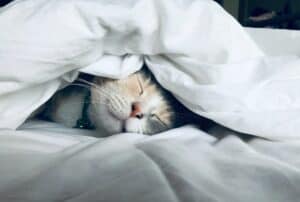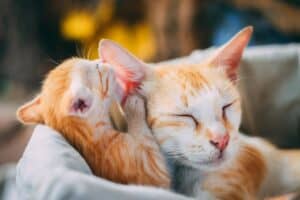| TL;DR: Like humans, cats have diphyodont dentition, meaning they have two sets of teeth throughout their lives. The first set of deciduous or milk teeth begins to emerge when cats are two weeks old. Within six weeks, the full set of 26 teeth is complete. As cats transition into adulthood, they develop 30 permanent teeth well before their first year. These teeth comprise: -12 incisors -4 canines -10 premolars -4 molars Cats can be affected by dental diseases. Developing an oral care routine that includes regular tooth brushing at least three times a week is crucial. |
The secrets of a cat’s mouth elude even the best of us. We often catch a fleeting glimpse of their pointy teeth when they feel content enough to yawn in our presence. However, that moment ends too quickly for us to grasp what is really happening inside.
It may not be widely known that, like humans, cats are also susceptible to dental diseases that can cause them pain. As they often conceal their discomfort, we must seek to understand their oral health. After all, it directly affects their overall well-being.
So, if you want to learn the intricacies of cats’ dental structure and how to keep their little and mysterious mouths healthy, this article is here to guide you.
Delving into the ins and outs of cats’ teeth will help you take proactive measures and keep them in perfect condition.
Types of Cat Teeth
As carnivores, cats have sharp, pointy teeth. They are nothing like herbivores’ or our human pearly whites. But nature is wise: it tailors the teeth’ shape and sizes to suit each species’ specific feeding habits and requirements.
Nevertheless, cats, humans and many other mammals share a common trait known as diphyodont dentition. What does that mean? We all develop two consecutive sets of teeth over our lives: an initial set of deciduous or milk teeth — destined to shed sooner rather than later — followed by a set of permanent teeth that emerge later.
| ???? Fun fact: Another similarity between cats’ and humans’ dentition is the number of teeth. Cats have 30 permanent teeth, only two fewer than the adult human dentition. In contrast, dogs develop a total of 42 permanent teeth. It’s certainly food for thought! |
Adult cats have four different types of teeth, each serving a specific function:
???? Incisors
These are the tiny, nipping teeth in the front of a cat’s mouth. They are a perfected grooming tool that can scratch any itch, remove old bits of claws and keep their coat clean and healthy. They are also useful for gripping and nibbling food, grass, or toys.
???? Canines
Four sharp, long and formidable fang-like teeth. In nature, canines can deliver a fatal bite to prey. Cats also tear and break down food with their canines. On the cute side, you might see these canines adorably peeking out from a sleeping cat’s mouth.
???? Premolars
Right behind the canines comes a set of 10 sharp and serrated chompers. While each side of their mouth holds an equal number of premolars, the upper jaw has six, while the lower jaw has only four. These wide teeth are used for grasping and chewing.
???? Molars
Situated at the back of a cat’s mouth, these four small but mighty teeth are used to chew hard food such as kibble and even bones. Kittens do not have deciduous molars; they only grow with an adult set of teeth.
Cats’ Teeth Through Life
Like most diphyodont mammals, kittens are born with no exposed teeth. This doesn’t mean that they are born without them. On the contrary, teeth develop during the kitten’s gestation period and are present just beneath the surface of the gums since birth.
Let’s take a closer look at the tooth cycle.
1. Kitten teeth
Milk teeth typically start erupting at three weeks. By the sixth week, all 26 primary teeth should be in place.
When do they emerge?
- 12 incisors at 2 to 3 weeks
- 4 canines at 3 to 4 weeks
- 10 premolars at 4 to 6 weeks
2. Teething
A permanent set will start developing from tooth buds underneath the milk dentition. As they grow, adult teeth will press against the roots of the deciduous teeth, eventually pushing them out.
Teething usually starts around 11 to 12 weeks of age. During this time, the cubs may become slightly irritable. Most kittens will have the urge to chew on anything within their reach to try and relieve their discomfort, even a friendly hand.
The incisors are the first teeth to be replaced, followed by canines and premolars. Finally, the molars will erupt. You may never even see a lost milk tooth, as they often go during mealtime or play.
3. Adult teeth
By the time your kitten reaches seven months, all 30 permanent teeth, including the molars, should be in place. The number and timeline for adult teeth eruption go like this:
- 12 incisors at 3 to 4 months
- 4 canines at 5 months
- 10 premolars at 4 to 6 months
- 4 molars at 4 to 6 months
How to Keep Your Cat’s Teeth Healthy
Cats have a secretive nature. They are simultaneously prey and predators, instinctively hiding any vulnerabilities to protect themselves from threats. Unfortunately, this tendency often leads to overlooked dental issues in many felines. More than 50% of cats over four years old experience some form of dental disease.
One of the most common dental problems in cats is periodontal disease, which arises from a bacterial infection caused by the accumulation of tartar. This condition weakens the structures supporting the teeth and can also lead to gingivitis (the reddening of the gums directly bordering the teeth).
As cats will not manifest their discomfort, the best strategy is a preventive oral care routine that checks most dental complications. However, some hints can help you identify if your cat is uncomfortable in their dentition.
Look out for symptoms such as:
???? Red gums
???? Brown tartar
???? Drooling
???? Missing or loose teeth
???? Smelly breath
???? Changes in eating habits (decreased appetite, difficulty chewing food, dropping food)
If you notice any of these, schedule a visit to the vet. Your pet may be in pain. As for preventing your cat from developing any of the above listed, here are some best practices and tips to ensure your cat’s dental health:
???? Brushing routine: taking care of those pearly whites
Home dental cleaning is vital in maintaining your kitty’s oral health. While brushing their teeth may initially seem challenging, positive reinforcement, rewards, and patience can teach your cat to tolerate and enjoy the routine. Ideally, aim for daily brushes, but a minimum of three times per week is also good.
Remember to use toothpaste specially designed for pets; products developed for humans can be toxic. Also, cat-friendly toothpaste flavors like chicken, beef and fish can help make brushing time less stressful.
???? Playtime with purpose: dental toys for healthy teeth
Dental toys aren’t just for dogs. Cats can enjoy and benefit from them too! These toys are designed for dental health maintenance, minimizing plaque and tartar accumulation. But that is not all; they are an excellent source of exercise and mental stimulation, which is so crucial for feline companions.
???? Treats that count: reward your cat with dental goodies
Remember: treats are no replacement for brushing. Moreover, many of these treats can be high in fat and calories. However, when used in the correct dose, they can help reduce plaque on your cat’s teeth while complementing the oral care routine. Dental treats can be a rewarding indulgence while contributing to good oral hygiene.
???? Experts’ guidance: the importance of regular vet check-ups
Regardless of your efforts at home, routine dental check-ups with your veterinarian are essential. During these visits, make sure they perform a comprehensive oral examination, checking for plaque buildup and signs of disease. Your vet has the expertise to unravel your cat’s dental secrets and help them stay healthy and purring happily.
| ???? Pro Tip: Look for products with the VOHC seal. The Veterinary Oral Health Council (VOHC) approves products that have undergone rigorous scientific tests and proven their effectiveness in promoting optimal oral health. |
Final Thoughts
Cats might seem like independent little beings in many ways, but they still rely on our care and attention. Taking care of their overall well-being means looking after their dental health too.
Dental diseases can be excruciating for our feline companions. So, the best way to keep them safe from dental issues is by using a regular oral care routine that includes brushing their teeth.
Remember, it is never too late to start caring for your kitty’s teeth. It may surprise you, but some kitties even grow to enjoy the attention and tasty treats they receive after teeth-brushing sessions.
| SOURCES Cornell Feline Health Center (2017). Feline Dental Disease. vet.cornell.edu Elfenbein, H. (2019). Gum Disease in Cats. petmd.com Myers, P. (2023). Milk teeth and the replacement of teeth. animaldiversity.org Schaible, L. (2019). Is It Normal for Cats to Lose Their Teeth? petmd.com Soltero-Rivera, M. (2022). Dental Development In Animals. msdvetmanual.com Weir, M. et al. (2023). Dental Disease in Cats. vcahospitals.com |





